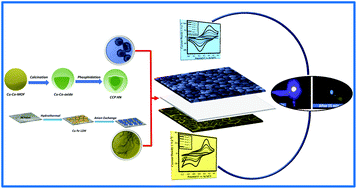Ultra-high energy density supercapacitors based on metal–organic framework derived yolk–shell Cu–Co–P hollow nanospheres and CuFeS2 nanosheet arrays†
Abstract
Owing to the increased requirement for efficient energy storage systems (ESs), investigating favorable electrodes with porous nanoarchitecture for supercapacitors (SCs) is vital. Nonetheless, the development of these kinds of electrodes to obtain high energy density remains a difficult task. Low specific capacitances of positive (cathode) and negative (anode) electrode materials are a serious obstacle that limits the performance of asymmetric SCs (ASCs). Herein, we proposed the preparation of yolk–shell Cu–Co–P hollow nanospheres (Y-CCP HN) as a positive electrode using a metal–organic framework (MOF) and CuFeS2 nanosheet (CFS NS) arrays as a negative electrode via a low-cost and simple hydrothermal route for ASCs. The Y-CCP HN and CFS NS electrodes exhibited significant specific capacitances (∼2043.3 F g−1 (340.55 mA h g−1) and 654.3 F g−1 (218.1 mA h g−1), respectively), considerable rate performances (∼77.55% and 63.2%, respectively, even at 24 A g−1), and exceptional durability (96.7% and 95.3% after 8000 cycles, respectively). Most notably, the Y-CCP HN//CFS device delivers a wonderful energy density of 158.4 W h kg−1 at a power density of 900.3 W kg−1, a notable specific capacitance of 352.1 F g−1 (176.05 mA h g−1), and excellent cyclability (96.1% after 8000 cycles). This exploration demonstrates a good strategy for the construction of other metal phosphides and sulfides with porous nature, emphasizing considerable prospects for next-generation ESs.



 Please wait while we load your content...
Please wait while we load your content...